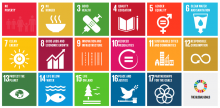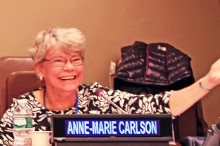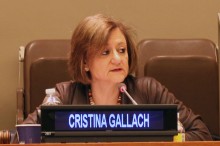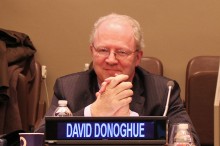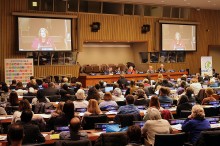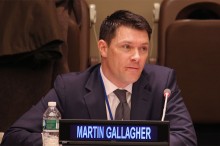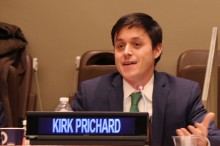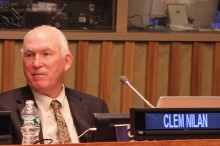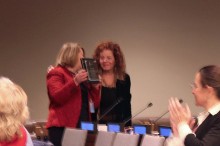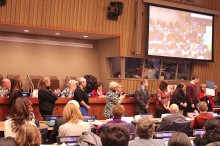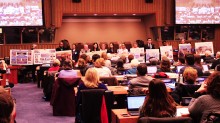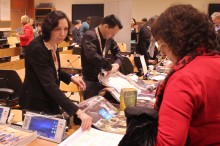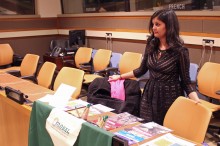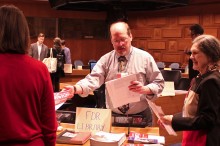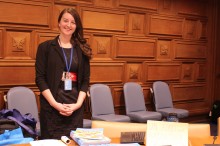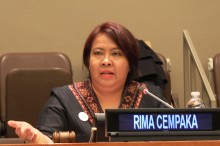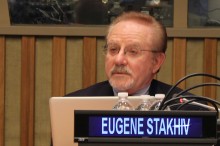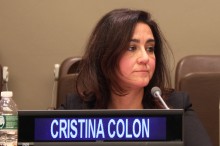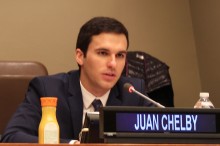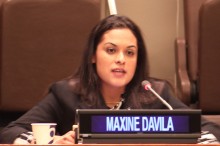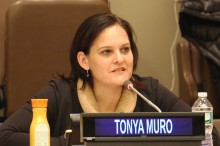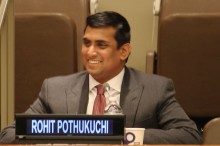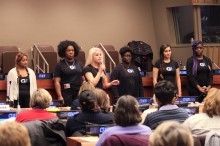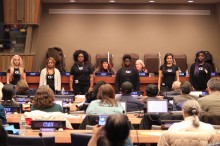2016 UN
17th Annual CTAUN Conference at UN Headquarters
STEWARDSHIP FOR A SUSTAINABLE WORLD: Education in the Sustainable Development Goals (SDGs)
22 January, 2016 – United Nations, NY
More than 500 educators and students participated in the all-day conference to learn more about the Sustainable 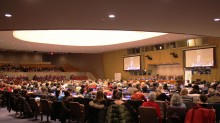 Development Goals. A detailed Conference Report has been posted on this page. You can also check out the blog posted by students from Lehigh University http://ctaun-lehighuni.blogspot.com/
Development Goals. A detailed Conference Report has been posted on this page. You can also check out the blog posted by students from Lehigh University http://ctaun-lehighuni.blogspot.com/
Never doubt that a small group of thoughtful committed citizens can change the world; indeed, it’s the only thing that ever has. Margaret Mead
With this underlying theme, all of the speakers at this year’s conference urged educators to commit themselves to teaching and promoting the UN’s 17 Sustainable Development Goals (SDGs) in their classrooms and in their communities.
“Sustainability,” we were reminded, “is development that can improve living conditions in the present, without depleting the earth’s resources for future generations.” Building on the achievements of the 8 Millennium Development Goals (MDGs), and following a World We Want consultation and MyWorld survey of people worldwide, including the most vulnerable, the SDGs were unanimously adopted by all 193 Member States at the UN General Assembly in September 2015. In brief, they include:
1. No Poverty 2. Zero Hunger 3. Good Health and Well-being 4. Quality Education 5. Gender Equality 6. Clean Water and Sanitation 7. Affordable and Clean Energy 8. Decent Work and Economic Growth 9. Industry, Innovation and Infrastructure 10. Reduced Inequalities 11. Sustainable Cities and Communities 12. Responsible Consumption and Production 13. Climate Action 14. Life Below Water 14. Life on Land 15. Peace, Justice and Strong Institutions 17. Partnerships for the Goals
WELCOME
Anne-Marie Carlson, Chair of the Committee on Teaching About the United Nations (CTAUN), welcomed 524 attendees to this year’s conference. She highlighted several groups, including 55 Fulbright Scholars from 30 countries, students and faculty from Randolph High School in Randolph, New Jersey, and Bellport High School in Brookhaven, Long Island, as well as several representatives of the Delta Kappa Gamma Society International, from locations around the United States and Mexico.
After reviewing the contents of the conference folders, Ms. Carlson began with a 2:58 minute video: “We the People for the Global Goals” http://www.globalgoals.org flashing the faces of people, (including some recognizable figures) of widely disparate nationalities, races, ages and occupations, but all committed to securing these goals in the next 15 years. The film creates an extraordinary sense of togetherness and determination.
She then introduced the opening speakers, Under Secretary General Cristina Gallach and Ambassador David Donoghue, who explained how the goals came into existence and why they are fundamental to the maintenance of a civilized society.
OPENING
Cristina Gallach – UN Under Secretary–General for Communications and Public Information
“Education is the building block of society.”
Ms. Gallach spoke about the partnership between CTAUN and DPI (the UN’s Dept. of Public Information) and how fundamental the link to the educational community is to the promotion of the UN’s agenda. “We are all colleagues,” she said, and pointed out that 200 young people were present at the UN when the goals were adopted on 25 September 2015. She mentioned the impactful statement made at that meeting by Malala Yousafzai, the Pakistani girl who, after recovering from an assassination attempt on the way to school, has become a forceful proponent of girls’ education. “The SDGs are for future generations,” Ms. Gallach added, “which is why curriculum is critical to creating informed citizens, aware of the challenges and capable of facing the responsibilities.”
But in all the curricula, there needs to be more than awareness. It must be followed by a plan of action for implementation. Young people must become engaged enough to actively demand achievement of the goals. “When a plan excites, there is transformation.”
H. E. Ambassador David Donoghue – Permanent Representative of Ireland to the UN, and co-facilitator, (with H. E. Ambassador Macharia Kamau, Permanent Representative, Kenya Mission to the UN,) gave an overview of the negotiations leading up to the adoption of the SDGs:
“Why have global goals”?
Leaders of countries, particularly those with limited resources, prioritize their projects, and common goals are inducements to progress by collaborative effort. Ambassador Donoghue pointed out, however, that because of the disparity in resources and capacity between developing
and developed countries, there was a need to make the goals aspirational, rather than mandatory. There are no sanctions against countries that
can’t fully comply, other than peer pressure, or what he called “political embarrassment.” Each country moves at its own pace, though all are committed to doing something. Some have asked whether 17 goals is too ambitious a number, but this seems to be a minority opinion, as the goals are, in so many ways, interwoven.
He explained how the SDGs differ from the Millennium Development Goals (MDGs) of the last 15 years. The latter were limited to 8 goals, focusing on the developing world and promulgated, top down, by UN staff. The 17 SDGs, on the other hand, are not intended simply for the developing world. As no country has a perfect rating economically, socially or environmentally (the 3 dimensions on which they focus), the SDGs are global in scope. They were initiated, as previously mentioned, through the bottom up “World We Want” consultation and “MyWorld” survey, and negotiated with leaders of all 193 Member States of the UN, each of whom had to agree to every word of the final statement. This tends to break down the North/South divide, which had given greater power and authority to the developed world. There are, by agreement, 169 subsidiary targets under the 17 headings – all countries, no matter where they are on the current spectrum, have somewhere to go.
The SDGs were not an overnight decision. He took us through the 3- year inclusive process, beginning with the Rio + 20 climate conference in 2012, through countless drafts and proposals, to the World Bank report “From Billions to Trillions” (what governments and business needed to supply to secure implementation) to the final August 2nd “document “The 2030 Agenda.” This focused on the 5 P’s (People, Planet, Peace, Prosperity and Partnership) from the Secretary-General’s Synthesis report of 2014. The aim is to reach those farthest behind first. In June/July of this year, ECOSOC, the UN’s Economic and Social Council, will host a high–level forum on implementation of the SDGs.
Like Ms. Gallach, Ambassador Donoghue spoke about “the infinite capacity of young people for activism” and the pivotal role they can play as advocates, if they are helped in a lively, inspiring way, to understand the real-life issues that the goals present,
MORNING PANEL: Ending Hunger
This session began with another 3:02 minute video “Global Goals for Sustainable Development” http://www.undp.org/content/undp/en/home/sdgoverview/post-2014-development-agenda/ produced by the United Nations Development Fund. (UNDP)
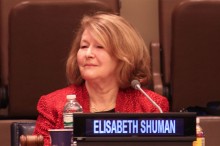 David Anthony – Chief of the Policy Advocacy and Coordination Unit at UNICEF was unable to attend. His remarks were read by Elisabeth Shuman, Vice-Chair of CTAUN, who also moderated the panel.
David Anthony – Chief of the Policy Advocacy and Coordination Unit at UNICEF was unable to attend. His remarks were read by Elisabeth Shuman, Vice-Chair of CTAUN, who also moderated the panel.
Food is the stuff of Life. Nothing else matters if it is lacking.
Prolonged hunger makes your body to slip into ketosis, and if it persists, leads to malnourishment – causing cognitive damage, inability to function, stunted growth and premature death.
Ending hunger is our most pressing intellectual challenge. Two-thirds of the world’s countries are classified as middle income, or high-income, yet 1 in 9 people, some 795 million, are undernourished. In Sub-Saharan Africa, the statistic rises to 1 in 3, most of whom are children. The greatest number are in Asia – two thirds of the world total. Within countries, hunger, is most widespread among the poorest and most
marginalized citizens – slum dwellers, women and children, indigenous groups, and the disabled. And yet, THERE IS MORE THAN ENOUGH FOOD TO GO AROUND. We have the money, technology and strategies to eliminate hunger. ACCESS IS A QUESTION OF POLITICAL WILL.
The goal of the MDGs was to cut those numbers in half. Growth in China helped, and the number of malnourished dropped significantly. But progress was uneven. Climate change and flooding undermined crops. 160 million children live in zones of drought. What is needed is education in nutrition and maximizing adequate resources for farmers, agri-business owners, retailers and distributors – with practical targets all along the food chain. NUTRITION IS A RIGHT, NOT A PRIVILEGE, AND HUNGER IS A VIOLATION OF HUMAN RIGHTS.
Martin Gallagher – Senior Liaison Officer, Zero Hunger Challenge, Office of the Special Representative for Food Security and Nutrition at the UN
“If the landfills cumulatively were a country, they’d be the 3rd or 4th largest emitters of greenhouse gasses.”
The Zero Hunger Challenge aims to bring together all stakeholders for collective action in service of sustainable, and resilient food systems for all people — a world free from hunger. This includes mobilizing political will among member states. Among the challenges he highlighted are overcoming rural poverty and supporting family farms. including empowerment of women as most small farmers are women. He highlighted 5 focal points, all of which need to be considered because of their interrelationship.
- Stunting – 165,000,000 children are stunted due to malnutrition. The problem echoes through generations – stunted children, unable to function cognitively, are more likely to live their adult lives in dire poverty, and consequently to have stunted children of their own.
- The need for 100% access to food and land – Farmers need to own the land they work, in order to make a profit, and small farmers especially need empowerment and investment in agriculture.
- Food that is sustainably produced
- Increased income so that farmers may have a livelihood
- Waste – 1.3 billion tons i.e. 1/3 of all food is wasted, and goes into landfills.
How we choose to grow, process, distribute and consume the food we eat will have a profound effect on people, planet, prosperity and peace, and will resonate across the 2030 Agenda.
Kirk Pritchard – Director of Humanitarian Programs at Concern Worldwide
“Every decision is political.”
Concern’s focus is on the most vulnerable people in the poorest parts of the least developed countries. Mr. Pritchard stressed the point that although there are no longer 1 billion people in extreme poverty, the spread is uneven. 40% of sub-Saharan Africa still lives on less than a dollar a day. 44% of mothers giving birth have no access to health care, so what would normally be minor complications can lead to the death of mother or child. In Northern Kenya, for example, it is a 2-day walk to the nearest clinic.
He talked about the link between conflict and famine. There is a 300% increase in famine in countries that are at war or just emerging from a conflict. Conflict is development in reverse. Countries at war can lose as much as 35 years of development gains. Former doctors and lawyers now marry their children off at the age of 12, just to insure that there will be bread on the table.
What can be done about this? Again, he placed the emphasis on education and an informed civil society.
Clem Nilan – General Manager of the Burlington, Vermont City Market Cooperative
“Co-ops act as safety nets, when even a small change in circumstances can reduce a family to poverty.”
The food system and co-op in Burlington, which serves as a model for others across the country, began in 1999, when a local grocery store went out of business. The population of 39,000 was left stranded, creating the opportunity for innovation. Yet initially, many were wary of the concept, due to pricing and food selection – as people become attached to favorite supermarket brands, they balk when these are no longer available.
Supporters stressed the organic, healthy foods that are not available in conventional supermarkets, as well as the fact that co-ops are member controlled. Community comes first. They employ some 250 million people worldwide, and recruit and empower women. In fact, 30% of Vermont farmers are women. Co-ops build sustainability by growing 40% of products locally. In addition the Burlington co-op gives a 10% discount to people on food stamps, to increase their buying power. Ultimately, 1000 households took part in the program.
When asked in a Q&A how to bring these principles into the classroom, Mr. Nilan spoke about 3rd graders using math skills to comparison shop in the market. He is also a supporter of fair trade.
SPOTLIGHT
Christine Ieronimo – author of the children’s picture book A Thirst For Home: A Story of Water Across the World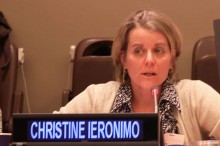
(See content and publishing information in our resources section.)
“When you educate a girl you educate a society.” Kofi Annan
She told us the touching story of how she came to adopt a 2 year-old girl in Ethiopia, and her visit with the mother who lived in crushing poverty with another daughter as well, which became the basis for the book. Having seen children drinking from puddles, her message is the need for clean water everywhere and for girls’ education. Walking miles every day for water prevents them from being in school.
She echoed the philosophy of former Secretary-General Kofi Annan that educated girls become more confident, marry later, have fewer children, and are less likely to have complications giving birth. They have the respect of their husbands, educate their own children to live healthier lives, become valued leaders in the community, and ultimately break the cycle of poverty.
PRESENTATIONS
A plaque was given to Professor Susan Katz, of the University of Bridgeport’s Advertising and Public Relations Department in recognition of the graphic arts and design work, including a new logo, which her class produced for CTAUN in 2015.
BEST PRACTICES –coordinated by CTAUN co-chairs Joan Goldstein and Mary Metzger See Details on Best Practices Section on the Website
POSTER CONTEST RECOGNITION – coordinated by Dr. Thomas Ward, Dean of the College of Public and International Affairs at the University of Bridgeport.
Winning posters were tied to the SDGs and covered such topics as the environment, climate change, social justice and education. Recipients represented a number of countries and universities. All received certificates of recognition from Anne-Marie Carlson. They included:
(University. of Bridgeport) Charles Coffee – Ghana, Sung Soon Gaval – NJ, Mohammad Haque – Bangladesh, Simon de Sena – US/Argentina, and Rebecca Bruckenstein – NY; (State University of NY at Buffalo) Sushmita Gelda & Antara Majumdar –US/India; (College of New Jersey) Jennifer Liang –China; (Pace University) Kingsley Bernard & Elayne Castillo; (Basalore College of Arts & Crafts in India) represented by Basanti Chakraborty, professor at NJ City University.
LUNCH BREAK & INFO FAIR –
InfoFair Exhibitors included: AFS-USA FDR Presidential Library and Museum FINCA Global Campaign for Education-US Global Concerns Classroom Heifer International iEARN-USA The Kazakhstan Permanent Mission to the UN – Aral Sea Project Reach the World UNA-USA U.N. Department of Public Information/ Outreach Division U.N. Food and Agriculture Organization The United Nations International School UN SDG Action Campaign UN Women UN World Food Programme U.S. Fund for UNICEF Y-Global Teens
Afternoon Intro – Ms. Carlson showed a 1 minute video The UN Global Goals: We Have a Plan https://vimeo.com/140799371 a light-hearted interpretation representing members of the UN General Assembly as animals of their countries, working to agree.
AFTERNOON PANEL: Taking Care of the Earth –
The panel was moderated by RIMA CEMPAKA, Sr. Advisor for Sustainable Development in the Office of the President of the General Assembly.
Eugene Stakhiv –Water Resources Engineer and Research Scientist, Visiting Scholar, Johns Hopkins University
Poverty reduction and economic development come first.
Dr. Stakhiv spoke about the politics of water, the federal response to Superstorm Sandy, and President Obama’s 70 principles for reengineering the NY city shoreline, which will take time. In the meantime, droughts and floods impede sustainable development, and bring down GDP. Yet disaster relief and risk reduction are not among the SDGs.
Many countries are fragile. He spoke about a human development index compiled by the World Bank, in which 40 countries are below .5 % GDP. 1.4 billion people lack safe drinking water, and 50% of the world’s population lack adequate sanitation. Yet there is some hope among what he called the BRICS countries –Brazil, Russia, India, China and South Africa, which have risen to 5-10% GDP.
70% of fresh water is used for irrigation. He spoke about Appalachia, which had once been similar environmentally to what Chad is today, but was brought out of poverty by the Tennessee Valley Authority (TVA) water project. He mentioned an integrated water resources management team to implement the SDGs, including, among others, the World Bank, UNDP and USAID.
But he believes that the SDGs need to be prioritized – working from the bottom up (poverty reduction) and top down (economic growth) simultaneously, since they are indelibly interwoven. Without these two components in place, the other goals will be less achievable.
Cristina Colon – Contributor to the UNICEF report on Children and Climate Change
“2015 was the hottest year on record.”
Ten of its 12 months tied or broke existing records going back 136 years. 2015 also had the strongest El Nino since 1997-8, which, though not created by climate change, can be exacerbated by it. In 2014, 87% of recorded disasters were related to climate, and in 2013, climate-related displacement affected 22.4 million people. Humanitarian agencies estimate that 250 million could be potentially impacted by 2050.
Who pays the highest price? Children. As temperature increases, together with water scarcity and air pollution, children will feel the deadliest impact of water-borne diseases and dangerous respiratory conditions. As emergencies expand, and climate-driven migration steadily rises, children’s lives and futures will be the most disrupted. Because they are disproportionately affected, climate change is an equity issue.
What can be done?
First and foremost, greenhouse gas emissions must be reduced to limit the rise in global temperatures to below 2 degrees Celsius –ideally to 1.5. The climate change agreement signed in Paris in December 2015 was a good start, but governments must be held accountable to insure that commitments are met. There is, she says, sufficient financial support for those countries that may have contributed least to the problem, but are suffering most from its consequences.
In addition to also supplying basic needs of safe water, sanitation, good hygiene, nutrition, food security, strong and accessible health systems, education and effective social protection systems, she says, children and young people must have a voice, and feel secure that their concerns are being heard.
Finally, national climate mitigation and adaptation policy must take children into consideration. In the next 15 years, $90 trillion is set to be invested in infrastructure and energy. If it is done so sustainably, and includes climate adaptation, the particular needs of children, especially the most vulnerable, can be met.
Juan Chebly – Lead Advisor, United Nations Environmental Programme (UNEP) and former Coordinator of The World We Want, UNDP
“People can’t be used as instruments of war.”
Human rights are linked to sustainable development. Without attention to issues of poverty and human need, there will always be war and
devastation. Defending human rights is everybody’s job. We have a right to oceans, forests and clean air. But with those rights comes responsibility. By 2050 it is estimated that there will be more plastic bottles in the ocean than fish. “It’s not only about large initiatives, but about trash in the streets.”
He believes that people want to be part of the solution, and asked us to look for opportunities to participate. “Do something every day,” he said. He urged us to use social media to raise our voices to governments for humanitarian aid for Syria, and to buy products from sustainably responsible companies. For teachers he mentioned UNICEF’s World’s Largest Lesson, (see CTAUN resources).
ROUNDTABLE: Committing to the SDGs
“It’s all about connection.”
Ramu Damodaran – Director of the United Nations Academic Impact (UNAI) introduced the panel of activists providing role models for our conference attendees. In doing so, he connected teaching individuals one-on-one, to the concept of “We the Peoples” which begins the UN Charter. “Multiply that one-on-one connection to the global level and generate solutions,” he said.
Mark Wise – Supervisor for Curriculum and Instruction K-12, West Windsor-Plainsboro, New Jersey School District
“Are you concerned about insuring a world where being born a girl doesn’t condemn a child to a life of danger and missed opportunities? ” (Options to students)
Committed to developing critical and creative thinking and the ability to function independently, he works with Middle School students in a 5-day Global Challenge program where regular classes are suspended, and students take charge of their own learning. Given 7 options, each 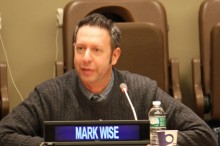 team focuses on an area of the SDGs most meaningful to them, researches it, and, at the end of the time period, presents its solutions to an outside panel, composed of parents, teachers and community leaders, who score the presentations, but don’t grade them. The winning team is awarded the opportunity to discuss their proposals via Skype with professionals in the field. Not only are students motivated and empowered, (800, participated over a one week period) but also the evaluation data on how well students researched, collaborated and organized their presentations is then used by the district to enable them to improve their own functioning as educators. To learn more, go to www.markwise8.wix.com/globalchallenge
team focuses on an area of the SDGs most meaningful to them, researches it, and, at the end of the time period, presents its solutions to an outside panel, composed of parents, teachers and community leaders, who score the presentations, but don’t grade them. The winning team is awarded the opportunity to discuss their proposals via Skype with professionals in the field. Not only are students motivated and empowered, (800, participated over a one week period) but also the evaluation data on how well students researched, collaborated and organized their presentations is then used by the district to enable them to improve their own functioning as educators. To learn more, go to www.markwise8.wix.com/globalchallenge
Maxine Davila – Founder 1+One: Networking for a Better World
What do the SDGs mean in a wealthy city where people are marginalized?
Ms Davila shared with us Project # SDGNYC , a newly created newsletter designed to encourage participation by New Yorkers in Agenda 2030. She also conducts youth workshops in 10 neighborhoods in all 5 boroughs to empower local people toward the achievement of greater opportunities, through awareness and understanding of the SDGs. Her mission is twofold: to help people become informed, and to encourage individual responsibility.
Tonya Muro – Executive Director, International Education, iEarn, USA
How do I make the world a better place?
iEarn is a global education coalition based in NYC that pioneered virtual global exchanges, linking classes in the US and 140 countries. It now engages about 50,000 teachers and 2 million students daily in online, collaborative project-based learning. Their mission is to provide professional development for teachers, and to create a professional community. Teachers can go on their website and connect to an ongoing project or create one of their own. www.iearn.org They are now accepting proposals for their annual conference and youth summit, which will be held in India in July.
Rohit Pothusuchi, Roundtable Moderator, serves on the Policy and Strategy Group for The World We Want 2015
Think globally and act locally.
Rohit is the founder of Verdentum, which means ‘green moment’, a non –profit social network that connects students worldwide with policy makers to work toward solving global problems. It works in 4 steps: the policy maker defines an issue on the Verdentum website www.verdentum.org Schools in multiple nations join the program, then video conference with one another to discuss the issue, and finally they all perform the work in their own communities prescribed by the policy maker.
SPOTLIGHT: G!rlBeHeard A Closing Perspective
If a girl can change her own life, she can change the lives of girls everywhere.
The conference ended on a dramatic note with a performance by a Theatre Group of young women called ‘G!rlBeHeard.’ Introduced by Peggy Kerry, member of the founder’s circle and NGO Liaison, US Mission to the UN, G!rl Be Heard uses theatre to create a world for young women to find strength, realize their potential, explore and rise above their challenging circumstances and society’s expectations of them, to become brave, confident, and socially conscious leaders. The girls had written, and performed, their personal perceptions of the SDGs
The writing was powerful and the performances moving.
Editor’s Note: Many thanks to Nancy Brown, Bill Hunter, and the Fulbright rapporteurs from Lehigh University for sending their notes: Qasim Ranjha, Serajuddin Jelalam, Mai Abdulfatah, Rohullah Naderi, Kelsey Leck, Nellie Gospodinova and Fayaz Amin. Thanks as always to Peggy Montgomery for reading the report and checking copy. – Toni Giangrande
To submit a project for the CTAUN Best Practices Award go to BEST PRACTICES AWARDS Note: Submissions for recognition at the 2016 Conference are closed; new entries will be considered for the 2017 Conference.
*InfoFair exhibitors include a number of UN agencies, plus educational organizations and NGOs.

